Male Pattern Baldness: Stages, Causes & Treatments
- What is male pattern baldness?
- What causes male pattern baldness?
- When does it start?
- What are the signs?
- What are the stages?
- Treatment options available
- Prevention
Male pattern baldness affects up to 98% of men at some point in life, and its results can be devasting. A sudden and unexplainable hair loss can rob a person of self-esteem and confidence.
Male pattern baldness can affect men and women of any age. By the time men reach 60, over two-thirds of men are reported to have experienced some degree of hair loss.
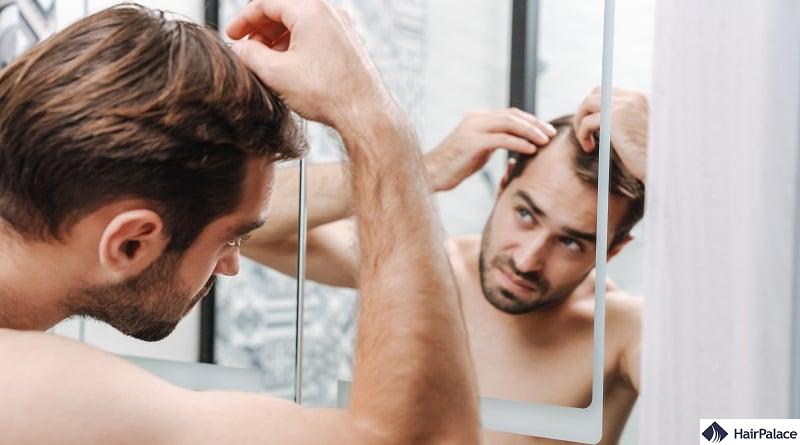
Especially if you’re a young person, losing your hair in this way can be incredibly upsetting. You’ll undoubtedly want information on potential solutions that slow hair loss in its tracks.
Today, we’ll explore everything you need to know about male pattern baldness, from the potential causes to the stages of hair loss, to what treatments are available for you to consider, and more.
What is male pattern baldness?
Male pattern baldness, also known as androgenic alopecia, is a genetic condition. Initially, it forms a receding hairline, but in time, the hair loss forms a ‘V shape’ on the crown of the head.
The results of male pattern baldness can be extreme, robbing most of the scalp of hair.
Two locations on our scalp, the back, and sides of the head are immune to the condition.
There are different degrees of pattern baldness. The Norwood scale is a helpful way of diagnosing the current state of hair loss you are in.
It has seven stages, each with visual diagrams and explanations. Doctors use this scale to diagnose a person’s condition and plan potential treatments.

What causes male pattern baldness?
The main cause of male pattern baldness is the conversion of the hormone testosterone into dihydrotestosterone, otherwise known as DHT.
The enzyme 5-alpha-reductase converts inactive testosterone into DHT, which promotes male features, including the development of the prostrate, body, and facial hair growth, and sadly, male pattern baldness.
Why does it cause the condition?
DHT is much more powerful than testosterone. It also attaches to cells easier and lasts longer. When it comes in contact with follicles, it shortens the hair growth cycle. This leads to hairs growing much shorter than normal.
Over time, the growing phase is reduced to such a degree that hair barely grows across the skin’s surface. Those that do grow may fall out easily.
DHT is essential for all other types of hair growth around the body. But it causes hair loss in the scalp – a phenomenon and mystery scientists are still trying to explain why.
When does male pattern baldness start?
| Age | Percentage of men with noticable hair loss | |||
|---|---|---|---|---|
| 20 | 20% | |||
| 30 | 25% | |||
| 50 | 50% | |||
| 60 | 66% |
Androgenetic alopecia, otherwise known as male pattern baldness, can start affecting men and women of all ages.
Most sufferers notice the early start of hair loss in their twenties, with up to 20% of men reporting gradual thinning in these early years.
Because your 20s are such a pivotal time in your life, any form of hair loss can be simply devastating. Sadly, by the time these men reach their 30s, there’s an increased change (25%) of noticeable baldness.
By age 50, over half of the men have reported noticeable hair loss. This increases to 66% by the time they reach 60, with men either having bald, patchy hair, or thinning hairlines.
While we commonly associate losing hair with getting older, that doesn’t make it any easier. After all, hair has always been a symbol of manliness, and when you lose hair, your self-confidence and self-esteem can fall.
And no matter your age, you understandably want to look your best. When hair falls out, it can be incredibly distressing.
But no matter what age stage of hair loss you are in, there is a hair loss treatment out there that can help your symptoms.
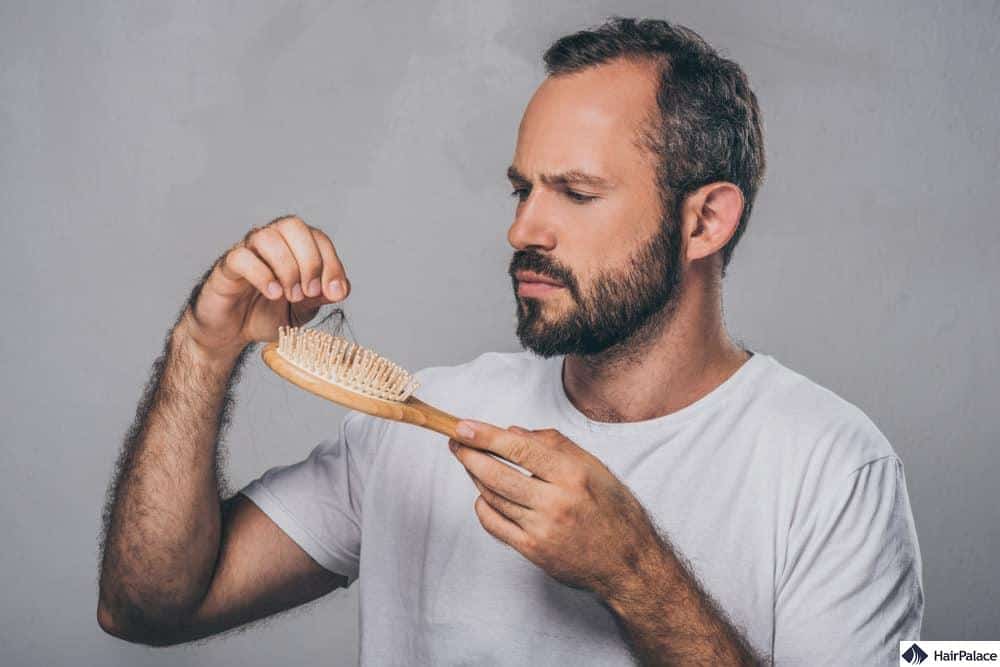
What are the signs of male pattern hair loss?
Male pattern baldness typically starts at your hairline. It will gradually recede, forming an ‘M’ shape at the top of your head.
Another area often affected early on is the back of your head, near the top. This often thins and expands gradually over time.
Over time, the hair on top of your scalp will become finer, shorter, and thinner. It will form a ‘U-shape’ pattern and may look brittle or even fall out quicker than you’d expect.
IF you suspect that you’re suffering fro hair loss it’s best to consult with a doctor to get an accurate male pattern baldness diagnosis.
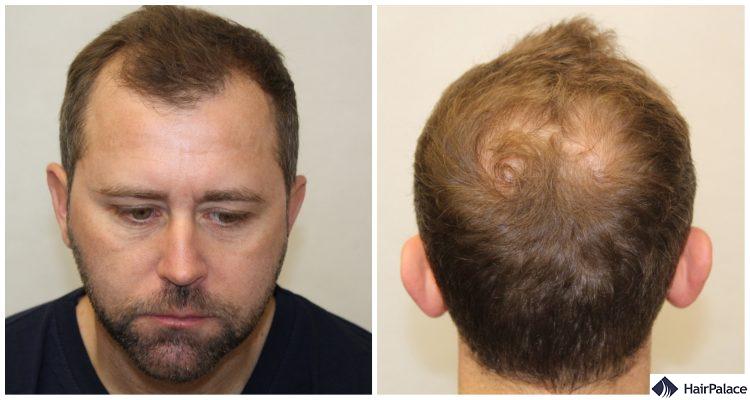
Male pattern baldness stages
So what exactly are the stages of male pattern baldness?
Specialists often use the Norwood male pattern baldness scale to mark the progress of hair loss in men and women.
Here are the 7 different types of male pattern baldness stages to be mindful of:
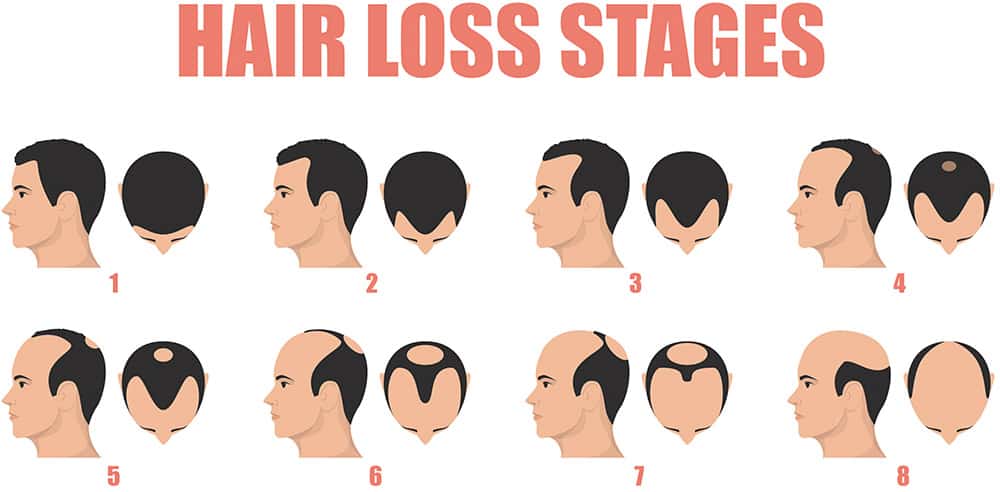
Stage 1
Your hairline looks perfectly normal, with no signs of any hair loss or thinning.
Stage 2
Gradually, hair loss begins, and your hairline may recede slightly. It may also become thinner, most noticeably around your temples. Stage 2 is often called the ‘mature hairline’. With some patients, this can be the full extent of hair loss suffered. However, for others it’s the first sign of male pattern baldness.
Stage 3
This stage sees more significant loss around the temple area, creating an M, V, or U-shaped appearance. We officially class this as the early stages of male pattern baldness, as hair loss and excessive thinning are easily visible.
Stage 4
Your receding hairline becomes much more pronounced, with little to no hair on the top of your scalp. A narrow band of hair follicles links patches of hair on the side of your head.
This is also the first stage where there are visible signs of early male pattern baldness crown hair loss.
Stage 5
Bald patches grow more prominently. The narrow band connecting sections of your scalp grows even thinner.
Stage 6
You will experience further hair loss, including in the areas around your temple. Sections on either side can disappear or become even thinner.
Stage 7
Your condition has reached its peak. The top of your scalp may suffer complete baldness, and you may only have small amounts of hair on either side or the back of your head. This stage can also be referred to as crown male pattern baldness, as this area becomes completely bald.
Is pattern baldness genetic?
We all know that old wive’s tale that men inherit baldness from their mother’s father. But is it all really down to lousy genetics and family history?
Research has shown that more than 80% of people experiencing balding have a father who also lost his hair. This evidence shows at least some evidence to support the theory of hereditary hair loss.
Scientists are still working to uncover the answers as to what genetic factors cause male pattern baldness. We can safely say that most scientists think the problem is polygenic, which involves more than one gene.
A study in 2017 on genes found that up to 63 genes could potentially play a role in developing the condition.
Some genes, like the AR gene, were highlighted as solid indicators of hair loss. Another fascinating study examining twins concluded that genetics accounts for up to 80% of male pattern baldness.
But there is still so much we need to learn about why this condition happens in the first place. While we may joke about inheriting patchy hair loss from our parents, it could very well be true!
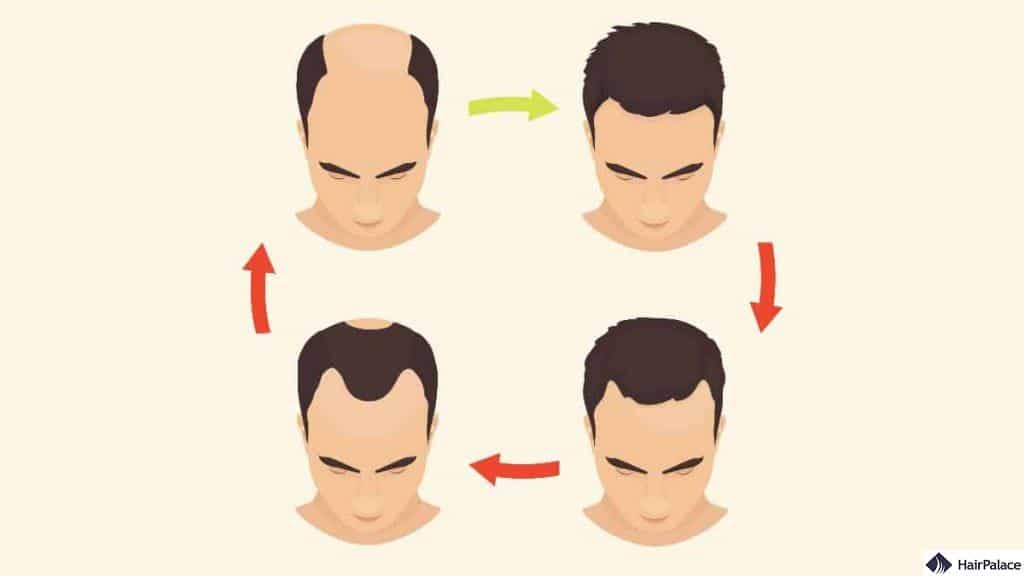
Latest treatment for male pattern baldness
Any hair shed from male pattern hair loss will sadly never grow back. This is due to the hormone DHT, which is the root cause of why a hair follicle shrinks permanently.
For this reason, we highly recommend early treatment as a preventative measure. While there is no definitive cure for male pattern baldness, several hair loss treatments can help alleviate symptoms.
The most popular solutions to male pattern baldness include:
Medications to stimulate hair follicles
Various medications claim they can help with treating hair loss and a receding hairline. It’s important only to take drugs with a proven track record for results.
The two most well-known and often effective medications to treat hair loss include Finasteride and Minoxidil.
Finasteride
Finasteride is a prescription medication used especially to treat male androgenetic alopecia, otherwise known as male pattern baldness. As a tablet, you take this drug daily for optimal results.
Finasteride works by limiting the conversion of testosterone to DHT, thus reducing DHT in your body.
Because DHT is thought to be the culprit of male baldness, limiting its presence in your body should slow down your condition.
A drawback to Finasteride is that because it only targets male sex hormones like testosterone and DHT specifically, it is not a suitable treatment for female pattern baldness.
Like any medication, there are risk factors that you should consult with your doctor before beginning treatment. These can include a hormone imbalance that results in erectile dysfunction or a decreased sex drive.
Also worth noting, the results of Finasteride are not permanent. You will need to continue treatment to maintain your results.
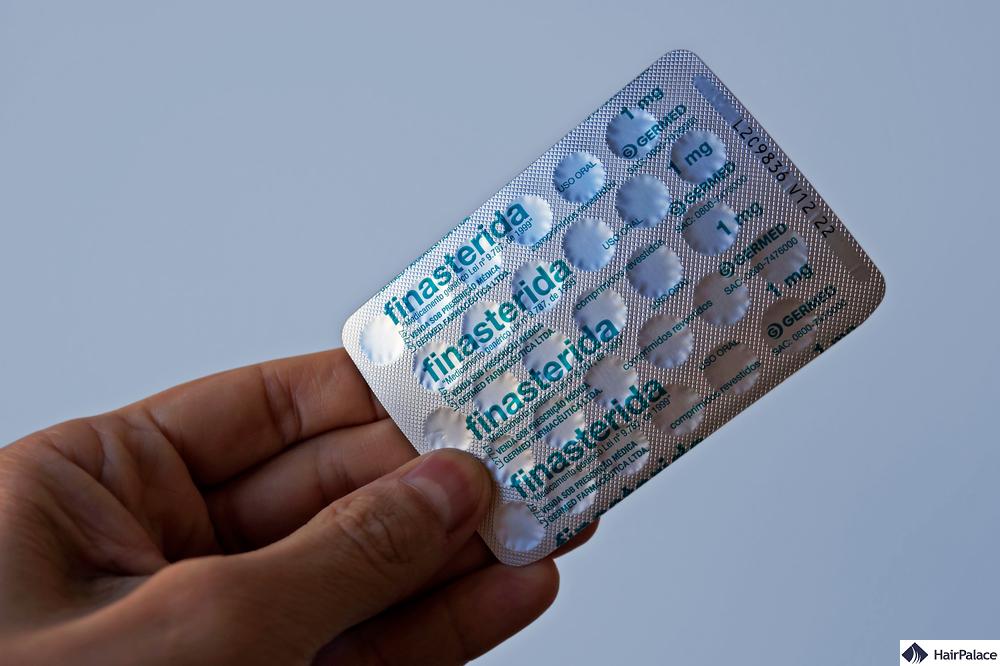
Minoxidil (Rogaine)
Minoxidil is another effective hair loss treatment that can help reverse the effects of hair loss. It is not a prescription medication, so it can be easier to start treatment right away.
There are two forms available – a topical Minoxidil treatment and a foam treatment.
Regardless of which you choose, you must apply them to your scalp every day to stimulate hair growth. Stopping treatment can lead to a reversal of results.
One of the advantages of using this drug is that it can be used to treat both male and female pattern hair loss. It can also be very effective in fighting against alopecia areata, also known as patchy hair loss.
Minoxidil has side effects, including dry skin and unwanted body and facial hair growth. Always consult your doctor before starting the medication.
And while organizations like The American Academy of Dermatology Association recognize the benefits of minoxidil, they state that it cannot regrow an entire head of hair. Once the medication has stopped, hair loss returns.

Platelet-rich plasma (PRP) therapy for hair growth
PRP is an innovative hair treatment that uses your own blood to nourish your hair. Like medication, it is not a permanent solution.
Your doctor will draw blood and place it into a specialized machine that separates the plasma from other components. This plasma is rich in nutrients and is injected directly under a hair follicle to stimulate new hair growth.
Although PRP can be effective, you must attend regular appointments to maintain results, which can be somewhat time-consuming. Most patients get one injection every month for three months.
Afterward, patients attend a top-up appointment every three to six months. Results usually appear within this time frame.
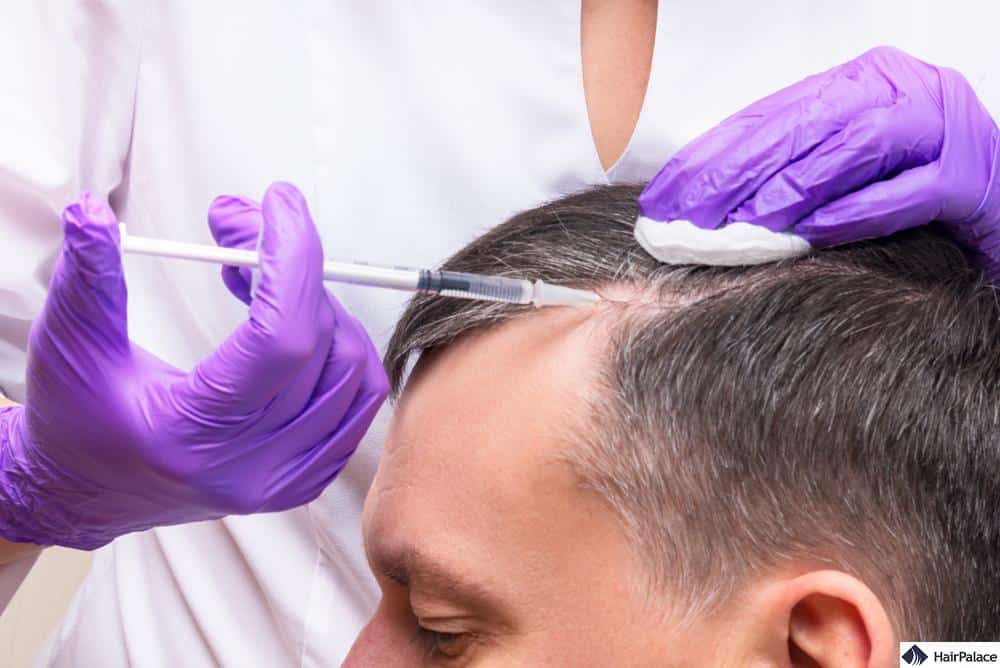
Laser treatment
Low-level laser therapy, also known as red light or cold laser therapy, works by irradiating photons into scalp tissues.
These are absorbed by weaker cells, encouraging them to grow. Targetting lasers on scalp hairs can help strengthen existing follicles and prevent hair breakage.
That said, hair regrowth results vary from laser treatment. While it can be effective against alopecia areata, the medical community and scientific research suggest that it works well for some people and does nothing for others.
Male pattern baldness hair transplant
Hair transplant surgery is constantly evolving. Every year, surgeons develop new techniques to tackle hair loss, creating better results in a quicker time.
This is the most popular male pattern baldness treatment, but modern procedures still require some essential criteria to achieve the best results.
Firstly, your hair must have reached a period of hair loss stagnation. When it has settled, a surgeon can properly assess the extent of your hair loss and devise a plan to correct it.
Secondly, you will need a supply of donor hair for when hair loss occurs. This hair is usually taken from the back and sides of your head – two areas often immune to male pattern baldness hair loss.
Using your own hair helps blend new hair growth with existing hair, creating a natural-looking hairline.
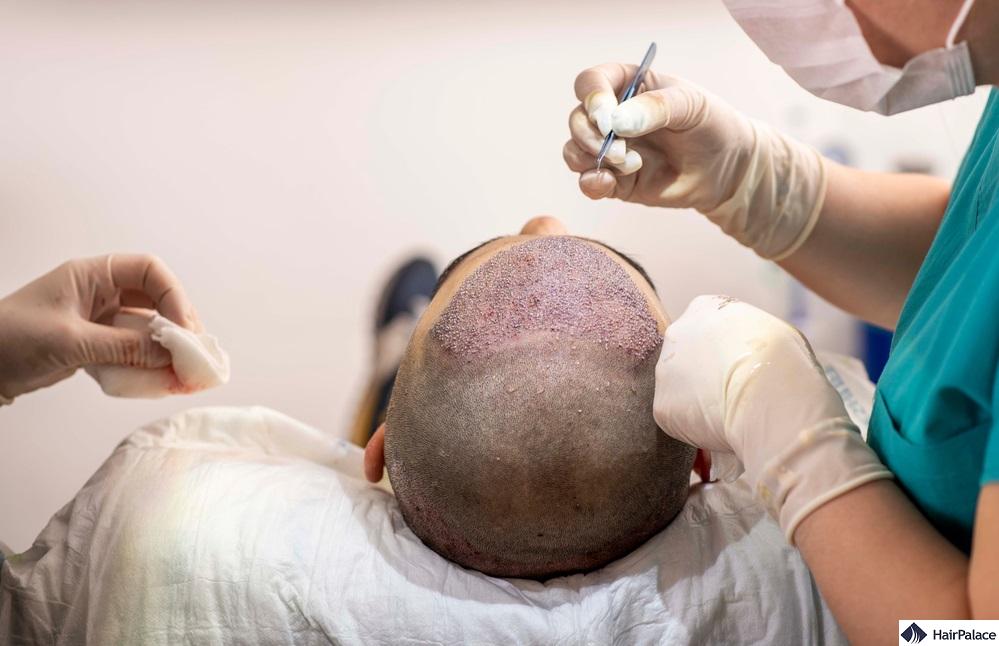
Can hair loss be prevented?
Currently, there is no known way to prevent male pattern hair loss. Several treatments can slow down baldness but require regular maintenance for optimal results.
However, the best hair treatment for male pattern baldness is a hair transplant.
This is the only practical way of treating thinning hair. A straightforward procedure can restore your entire scalp, improve hair density, and create a natural, full hairline.
If you want more information on hair transplants and are curious to see what a hair transplant for male pattern baldness can achieve, book a free hair transplant consultation with our expert team today.
During the consultation, our team will explore all options with you. We will discuss your health and medical background and offer tailored advice to yield the best restoration results in the quickest time.

FAQ
Hair won’t grow back when it falls out because of male pattern baldness. This condition is identifiable by a heavily receded hairline and thinning crown, progressing gradually over the years. However, hair will still grow at the back of the scalp and above the ears.
No cure for male pattern baldness is available at present, though medications such as minoxidil and finasteride can help combat hair loss. They may also regrow hair lost due to various causes, including male pattern baldness.
Take the following steps to fight male pattern baldness:
● Take vitamins and minerals, such as vitamins B7 (biotin), D, C, and iron.
● Use mild shampoo to wash your hair gently.
● Massage your scalp with essential oils to improve circulation.
● Eat more protein — one of the building blocks of hair.
● Massage green tea into your hair, which can improve hair growth.
● Drink at least eight glasses of water per day to stay hydrated.
● Never brush your hair while it’s wet.
Male pattern baldness never stops naturally. If you’re unhappy with your hair loss, you may consider treatment (such as a hair transplant).
Male pattern baldness, also known as androgenetic alopecia, typically begins between the ages of 20 and 30, but it can start as early as the late teens for some men.
It’s a genetic condition that can be inherited from either the mother’s or father’s side.
Stress can potentially accelerate male pattern baldness in individuals who are genetically predisposed to the condition. Stress can lead to a temporary increase in hair shedding, known as telogen effluvium, which might hasten the onset or progression of hair loss in those already susceptible to male pattern baldness.
Hair transplantation is the most effective way to treat male pattern baldness. It’s also the only treatment that gives a permanent solution to the problem.
Smoking does not directly cause male pattern baldness, but it can contribute to hair loss and may exacerbate the condition due to its negative impact on circulation and damage to hair follicles.
Male pattern baldness can begin as early as the teenage years, though it more commonly starts in a man’s 20s and 30s.
Last medically reviewed on November 6th, 2023
- Male pattern hair loss: current understanding by David A. Whiting, MDhttp://www.hairlosssucks.com/download/whiting.pdf
- Rathnayake D, et al. Male androgenetic alopecia. 2010https://www.tandfonline.com/doi/full/10.1517/14656561003752730
- Hamilton J.B. Male pattern hair loss in man. Ann NY Acad Sci. 1951; 53: 708-728https://www.cidjournal.com/article/S0738-081X(00)00128-0/fulltext
- Vera H. Price. Treatment of Hair Loss. N Engl J Med 1999; 341:964-973.https://www.nejm.org/doi/10.1056/NEJM199909233411307


